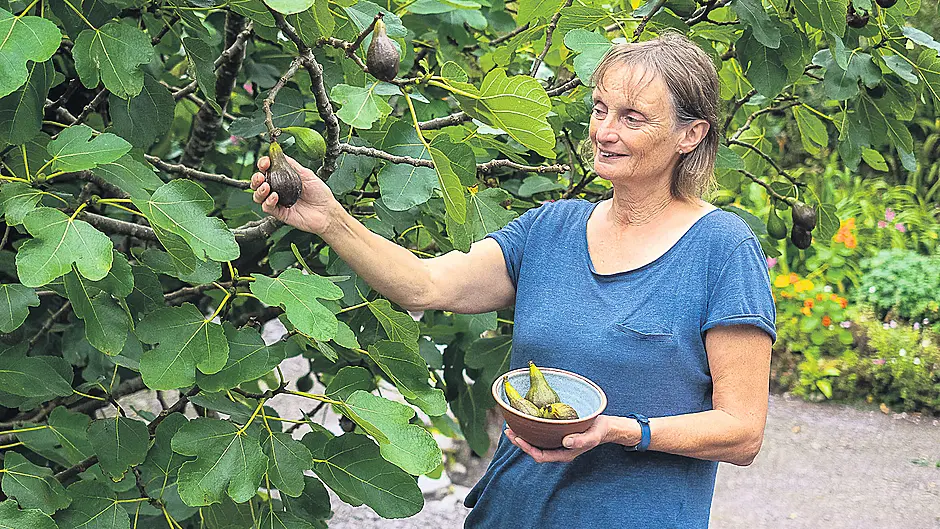BY JOYCE RUSSELL
THIS really is the season of mists and mellow fruitfulness, although we often seem to get some fine, dry, summer weather even though autumn is tapping us on the shoulder. Things can change fast at this time of year, so don’t take the weather for granted. Be sure to support and tie in tall plants that are expected to stand through the winter. And remember that there is still time to sow lettuce, salad greens, spinach and spring cabbage or to buy some young plants to grow on in the kitchen garden.
Harvest fruit
Lots of fruits ripen and are ready to pick this month. Some plants may produce smaller fruits than in other years, if water was in short supply while they were swelling, but harvests should be sweet after all the summer sun. If you have to tug hard or cut stems, then the fruit isn’t ready for picking. A perfect pear, plum or apple stem should break free as you lift the fruit.
Figs are a delicious treat and they are at their best now. Look for a good deep colour and squeeze gently to be sure the flesh is ripe. Ripe figs flop down on the stem – be sure to pick at this point or they will fall and litter the ground.
Autumn fruiting raspberries and ever-bearing strawberries can keep cropping until the first hard frost. You won’t get as many berries as from the prolific summer fruiting varieties, but they are a delicious fresh treat as autumn progresses.
Some fruit problems
Pick up any windfall fruits. These may be bruised or split and should be used quickly before they deteriorate. You can use them to make jams, jellies and chutneys, or make purée to go in the freezer.
Watch out for mould on grapes if you have a greenhouse vine. Ripening bunches need plenty of sun and excellent air circulation. Strip back the foliage if needed. If some bunches start growing grey mould then harvest all healthy ripe ones and use them to make preserves, juice or wine. You can even dry your own grapes if you have a food dryer, dehydrator, or very low temperature oven.
Wasps and birds can also be a problem. They can destroy lovely ripe fruit if you are slow to pick. Check fruit trees regularly and do your best to get the harvest before pests do.
Wasp traps can be hung in trees and you can cover fruiting branches so birds can’t gain access, but it is much easier to share a bumper harvest and accept that there might be some losses!
Use the vegetable glut
Sound potatoes, onions, carrots, parsnips, beetroot, onions and garlic will all store for many months if kept in a cool dry place. Exclude light from the storage area to avoid potatoes turning green and check regularly to make sure there are no problems in storage. Onions and garlic store fine in the house too. Try to put them in a cool place and make sure the necks are dry before storing.
Green beans, courgettes and tomatoes are all cropping extremely well this year. These will start to degrade if left for a week or more after harvesting. Use them when at their peak and make chutneys, pickles and cooked dishes for the freezer.
And if you have more spinach than you know what to do with, try making spinach dahl. Put some in tubs in the freezer so you have a delicious instant meal when you need it.
Buy bulbs
I always buy some fresh flower bulbs at this time of year. I plant them in pots and containers to brighten up around the outside of the house next year.
Try to get a mix of early and late flowering bulbs and remember you can put more than one type in a pot. Aim for complementary heights and flowering periods that give a good stretch of colour. You can plant the bulbs out into the garden once they have finished flowering.
It’s always worth trying something new – you can do a little research to find out what might do well, or take a chance on something exciting, provide the best home for it that you can and cross your fingers!
Keep an eye out for autumn planting onion sets and garlic. If you have a problem with white rot in your garden, then planting these crops in September might be the best way to get around it. Autumn planting means bulbs reach a good size before white rot strikes and if you have to lift the lot in late June you can still get brilliant crops.
Try fruithillfarm.com if you want a wide choice of garlic and try to get it into the ground in the last week of September or early October.







